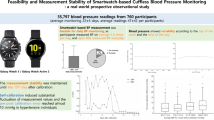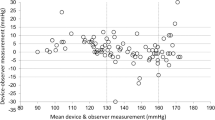Abstract
Ambulatory blood pressure monitoring is an important tool in hypertension diagnosis and management. Although several ambulatory devices exist, comparative studies are scarce. This study aimed to compare for the first time brachial blood pressure levels of Spacelabs 90217A and Mobil-O-Graph NG, under static and ambulatory conditions. We examined 40 healthy individuals under static (study A) and ambulatory (study B) conditions. In study A, participants were randomized into two groups that included blood pressure measurements with mercury sphygmomanometer, Spacelabs and Mobil-O-Graph devices with reverse order of recordings. In study B, simultaneous 6-h recordings with both devices were performed with participants randomized in two sequences of device positioning with arm reversal at 3 h. Finally, all the participants filled in a questionnaire rating their overall preference for a device. In study A, brachial systolic blood pressure (117.2±10.3 vs 117.1±9.8 mm Hg, P=0.943) and diastolic blood pressure (73.3±9.4 mm Hg vs 74.1±9.4 mm Hg, P=0.611) did not differ between Spacelabs and Mobil-O-Graph or vs sphygmomanometer (117.8±11.1 mm Hg, P=0.791 vs Spacelabs, P=0.753 vs Mobil-O-Graph). Similarly, no differences were found in ambulatory systolic blood pressure (117.9±11.4 vs 118.3±11.0 mm Hg, P=0.864), diastolic blood pressure (73.7±7.4 vs 74.7±8.0 mm Hg, P=0.571), mean blood pressure and heart rate between Spacelabs and Mobil-O-Graph. Correlation analyses and Bland–Altman plots showed agreement between the monitors. Overall, the participants showed a preference for the Mobil-O-Graph. Spacelabs 90217A and Mobil-O-Graph NG provide practically identical measurements during the static and ambulatory conditions in healthy individuals and can be rather used interchangeably in clinical practice.
This is a preview of subscription content, access via your institution
Access options
Subscribe to this journal
Receive 12 digital issues and online access to articles
$119.00 per year
only $9.92 per issue
Buy this article
- Purchase on Springer Link
- Instant access to full article PDF
Prices may be subject to local taxes which are calculated during checkout




Similar content being viewed by others
References
Kearney PM, Whelton M, Reynolds K, Muntner P, Whelton PK, He J . Global burden of hypertension: analysis of worldwide data. Lancet 2005; 365: 217–223.
Lim SS, Vos T, Flaxman AD, Danaei G, Shibuya K, Adair-Rohani H et al. A comparative risk assessment of burden of disease and injury attributable to 67 risk factors and risk factor clusters in 21 regions, 1990-2010: a systematic analysis for the Global Burden of Disease Study 2010. Lancet 2012; 380 (9859): 2224–2260.
ESH/ESC Task Force for the Management of Arterial Hypertension. Practice guidelines for the management of arterial hypertension of the European Society of Hypertension (ESH) and the European Society of Cardiology (ESC): ESH/ESC Task Force for the Management of Arterial Hypertension. J Hypertens 2013; 31: 1925–1938.
Omboni S, Parati G, Palatini P, Vanasia A, Muiesan ML, Cuspidi C et al. Reproducibility and clinical value of nocturnal hypotension: prospective evidence from the SAMPLE study. Study on Ambulatory Monitoring of Pressure and Lisinopril Evaluation. J Hypertens 1998; 16: 733–738.
Mancia G . Short- and long-term blood pressure variability: present and future. Hypertension 2012; 60: 512–517.
Stenehjem AE, Os I . Reproducibility of blood pressure variability, white-coat effect and dipping pattern in untreated, uncomplicated and newly diagnosed essential hypertension. Blood Press 2004; 13: 214–224.
Bliziotis IA, Destounis A, Stergiou GS . Home vs ambulatory and office blood pressure in predicting target organ damage in hypertension: a systematic review and meta-analysis. J Hypertens 2012; 30: 1289–1299.
Gaborieau V, Delarche N, Gosse P . Ambulatory blood pressure monitoring versus self-measurement of blood pressure at home: correlation with target organ damage. J Hypertens 2008; 26 (10): 1919–1927.
Sega R, Facchetti R, Bombelli M, Cesana G, Corrao G, Grassi G et al. Prognostic value of ambulatory and home blood pressures compared with office blood pressure in the general population: follow-up results from the Pressioni Arteriose Monitorate e Loro Associazioni (PAMELA) study. Circulation 2005; 111: 1777–1783.
Dolan E, Stanton A, Thijs L, Hinedi K, Atkins N, McClory S et al. Superiority of ambulatory over clinic blood pressure measurement in predicting mortality: the Dublin outcome study. Hypertension 2005; 46 (1): 156–161.
Fagard RH, Celis H, Thijs L, Staessen JA, Clement DL, De Buyzere ML et al. Daytime and night-time blood pressure as predictors of death and cause-specific cardiovascular events in hypertension. Hypertension 2008; 51: 55–61.
Minutolo R, Agarwal R, Borrelli S, Chiodini P, Bellizzi V, Nappi F et al. Prognostic role of ambulatory blood pressure measurement in patients with nondialysis chronic kidney disease. Arch Intern Med 2011; 171: 1090–1098.
Fagard RH, Thijs L, Staessen JA, Clement DL, De Buyzere ML, De Bacquer DA . Prognostic significance of ambulatory blood pressure in hypertensive patients with history of cardiovascular disease. Blood Press Monit 2008; 13: 325–332.
Sarafidis PA, Rumjon A, Macdougall IC . Ambulatory blood pressure monitoring: an invaluable tool comes of age for patients with chronic kidney disease? Am J Nephrol 2012; 35 (3): 238–241.
Lovibond K, Jowett S, Barton P, Caulfield M, Heneghan C, Hobbs FD et al. Cost-effectiveness of options for the diagnosis of high blood pressure in primary care: a modelling study. Lancet 2011; 378 (9798): 1219–1230.
Sarafidis PA, Georgianos PI, Karpetas A, Bikos A, Korelidou L, Tersi M et al. Evaluation of a novel brachial cuff-based oscillometric method for estimating central systolic pressure in hemodialysis patients. Am J Nephrol 2014; 40 (3): 242–250.
Weiss W, Tölle M, Zidek W, van der Giet M . Validation of the mobil-O-Graph: 24h-blood pressure measurement device. Blood Press Monit 2010; 15 (4): 225–228.
Franssen PM, Imholz BP . Evaluation of the Mobil-O-Graph new generation ABPM device using the ESH criteria. Blood Press Monit 2010; 15 (4): 229–231.
Baumgart P, Kamp J . Accuracy of the SpaceLabs Medical 90217 ambulatory blood pressure monitor. Blood Press Monit 1998; 3: 303–307.
Santucci S, Cates EM, James GD, Schussel YR, Steiner D, Pickering TG . A comparison of two ambulatory blood pressure monitors, the Del Mar Avionics Pressurometer IV and the Spacelabs 90202. Am J Hypertens 1989; 2: 797–799.
O’Shea JC, Murphy MB . Ambulatory blood pressure monitoring: which arm? J Hum Hypertens 2000; 14: 227–230.
Kallem RR, Meyers KE, Sawinski DL, Townsend RR . A comparison of two ambulatory blood pressure monitors worn at the same time. J Clin Hypertens (Greenwich) 2013; 15 (5): 321–325.
Márquez Contreras E, López de Andrés M, Casado Martínez JJ, Martín de Pablos JL, Moreno García JP, López Zamorano JM . Evaluation of Spacelabs 90207, the noninvasive automatic monitor for ambulatory monitoring of blood pressure. Aten Primaria 1998; 21 (2): 105–108.
O'Brien E, Mee F, Atkins N, O'Malley K . Accuracy of the SpaceLabs 90207 determined by the British Hypertension Society protocol. J Hypertens 1991; 9 (6): 573–574.
Parati G, Stergiou G, O'Brien E, Asmar R, Beilin L, Bilo G et al. European Society of Hypertension practice guidelines for ambulatory blood pressure monitoring. J Hypertens 2014; 32: 1359–1366.
Westhoff TH, Straub-Hohenbleicher H, Schmidt S, Tölle M, Zidek W, van der Giet M . Convenience of ambulatory blood pressure monitoring: comparison of different devices. Blood Press Monit 2005; 10 (5): 239–242.
Author information
Authors and Affiliations
Corresponding author
Ethics declarations
Competing interests
The authors declare no conflict of interest.
Rights and permissions
About this article
Cite this article
Sarafidis, P., Lazaridis, A., Imprialos, K. et al. A comparison study of brachial blood pressure recorded with Spacelabs 90217A and Mobil-O-Graph NG devices under static and ambulatory conditions. J Hum Hypertens 30, 742–749 (2016). https://doi.org/10.1038/jhh.2016.11
Received:
Revised:
Accepted:
Published:
Issue Date:
DOI: https://doi.org/10.1038/jhh.2016.11
This article is cited by
-
Accuracy of 24 h ambulatory blood pressure recordings for diagnosing high 44 h blood pressure in hemodialysis: a diagnostic test study
Hypertension Research (2024)
-
Effect of patient gender on short-term blood pressure variability in hemodialysis patients
Journal of Human Hypertension (2022)
-
Association of peridialytic, intradialytic, scheduled interdialytic and ambulatory BP recordings with cardiovascular events in hemodialysis patients
Journal of Nephrology (2022)
-
Peridialytic and intradialytic blood pressure metrics are not valid estimates of 44-h ambulatory blood pressure in patients with intradialytic hypertension
International Urology and Nephrology (2022)
-
Ambulatory blood pressure profile and blood pressure variability in peritoneal dialysis compared with hemodialysis and chronic kidney disease patients
Hypertension Research (2020)



